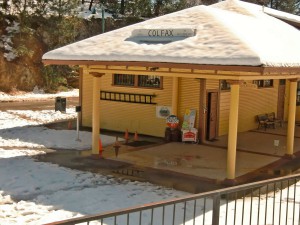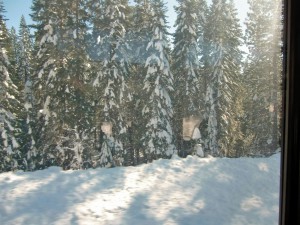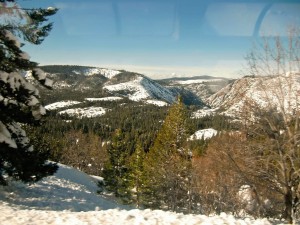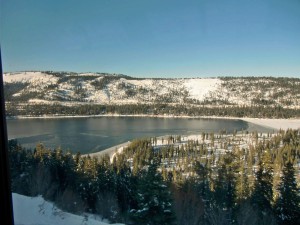IN SEARCH OF SNOW – HEADING EAST THROUGH THE SIERRAS
IN SEARCH OF SNOW
This is the second in a series of articles about traveling by rail in search of snow
HEADING EAST THROUGH THE SIERRAS
By Charles N. Stevens
Photos by Dolores Seidman
Waiting at the Amtrak station in Emeryville on a brisk morning, we anticipate the excitement of heading across the country to Chicago on the California Zephyr. Soon the silver cars of the train snake into the station, its powerful locomotive throbbing.
Leaving on time at 9:15 a.m., the train whisks us by the blue San Francisco Bay, the city itself gleaming far across the water. The scenery flies by our high-level windows—a fisherman on the rocks by the track, coots, canvas back and bufflehead ducks cruising in the still waters, a huge black tanker with a tan superstructure taking on fuel. Old pilings, weathered and rotten protrude from the water, the remains of old piers, docks or warehouses, relics of another day. At one point hundreds parque hinchable of ducks swim away from the intrusion of our train, leaving rippling water behind them.
Oil storage tanks, like giant pill boxes, are everywhere in Martinez, the faint smell of petroleum in the air. After crossing the great Martinez Bridge we look out on the Navy’s Mothball Fleet in the back bay, warships that have seen their day and are no longer needed, but could be readied again. It is sad to see all that former might resting in a naval graveyard.
We now travel through marshes surrounded by rounded green hills dotted with oaks. When the Zephyr stops for a signal in the marsh, an area of gray and reddish grasses and small rocky islets, we are given an unusual view. Egrets hunt, still as statues. Ducks swim among the grasses and coots feed on the bottom with their rears in the air.
The land then begins to flatten out into vast vegetable and alfalfa fields of the Delta Area as we rush eastward. We pause at the picturesque station at Davis, home of one of the University of California’s campuses, then cross the Sacramento River into the state capital.
Not long after leaving Sacramento our train begins to climb into the foothills of the Sierras. We pass green horse pastures surrounded by white fences, the typical Digger pines with their gray-green foliage and forests of oaks. As our altitude increases, small patches of snow appear under the shade of the trees.
There is plenty of snow as we reach Colfax at 2421 feet. The roads are clear in the old town, the lumpy snow piled at the sides. Brick buildings side by side with corrugated steel awnings form the town, snow, like mattresses, lying on the roofs. As we pause at the station, I look out at two black dogs that are frisking with each other in the deep snow, flinging it everywhere in their scampering, having fun.
From Colfax we begin our ascent into the Sierras, into the ponderosa pines, firs and then sugar pines, the snow deeper and fluffier. We had hoped for a snow storm but the day is clear and dazzling, trees casting bluish shadows on a sea of whiteness. We often look down steep slopes with grand vistas as our train grinds slowly up the grade. Foot-deep snow decks roofs and parked cars and lines the branches of trees. Trees become laden with it, as though they are wearing it, their branches weighted down. Smooth white drifts cover the land, small trees protruding from them hooded like icy ghosts while long icicles hang from boulders. Adjectives like creamy, whipped cream, sea foam and meringue come to mind. Our train ducks through tunnels and long snow sheds, travels along ridges with spectacular views of the American River and Lake Spaulding.
Skiers race down the slopes near our highest point, about 6000 feet, where we begin to have our best views of Donner Lake, still frozen in its shallowest parts. We recall the tragic story of the Donner Party, their progress blocked by winter snows, their starvation leading to unspeakable horrors. Boulders wear thick white caps as we round curves and begin our long descent.
At the base of the eastern slope of the Sierras lies Truckee half buried in snow. An old lumber town, once noted for its lawlessness and saloons, it had burned down six times in the past. Today its main street is lined with brick buildings abutting each other. Long icicles hang from roof eaves and mountains of snow plowed from the roads cast long shadows in the late afternoon. I watch a long icicle from the station roof, dripping slowly at its tip, each drop catching a bit of the sun. A man shovels snow off his truck trailer. Boulders capped with snow look like great mushrooms.
After stopping at Reno and Sparks in Nevada we begin our trip over the desert, only the highest hills dusted with snow, then none at all. The Truckee River, gushing swiftly and turbulently out of the Sierras, is calmer here, reflecting the last light of the day.
As night falls, all is black out of the train windows, only headlights now and then from cars on the road in all that inkiness. After dinner in the diner, we return to our compartment, an attendant having made up our bunks. We are ready for a good night’s sleep.

By the time we reach Colfax in the Sierra Foothills, snow is on the ground.

As we climb higher through the Sierras, snow clings to the trees.

From our observation car window we see spectacular mountain vistas on all sides.

We pass Donner Lake, named to memorialize the Donner Party who nearly perished here.



